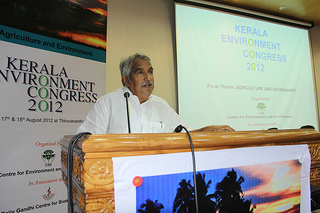/topics/biological-pollution
Biological Pollution
Delhi’s ground water hits rock bottom
Posted on 20 May, 2013 12:40 PMGreen pastures and meadows, tall trees, lakes, wells and the river…those are my memories of Delhi. It wasn’t too long ago that one woke up early to the sounds of lawns being watered, children running off to school and people walking in the parks. A flurry of activity but quite different from what it is today.

River water quality data by Central Pollution Control Board (2005)
Posted on 19 Mar, 2013 06:41 PMAgainst this backdrop, this document by the Central Pollution Control Board (CPCB) elaborates on the river water quality in India. The Central and State Pollution Control Boards / Pollution Control Committees in Union-Territories of India are responsible for restoration and maintenance of the wholesomeness of aquatic resources.
Engineer, activist, Mahant, 'Hero of the Planet' Veer Bhadra Mishra is no more
Posted on 14 Mar, 2013 11:17 AM
Manuals for preparation of detailed project report for rural piped water supply schemes by Ministry of Drinking Water and Sanitation
Posted on 08 Mar, 2013 05:33 PMThe works have to done maintaining appropriate standards and quality of the schemes, and ensure their completion in time. The manuals are prepared keeping in mind the activities mentioned in the 12th five year plan.
Uniform drinking water quality monitoring protocol- A document by Ministry of Drinking Water and Sanitation (2013)
Posted on 07 Mar, 2013 08:36 PMThese protocols are suggestive in nature and will be useful for laboratory personnel, water supply engineers and policy makers working in the drinking water sector operating at State, District and Sub-district levels.
Influence of anthropogenic contamination on fluoride concentration in groundwater: A study of Mulbagal town, Kolar district, Karnataka
Posted on 15 Feb, 2013 04:53 PMGroundwater contamination is a serious, but relatively ignored issue in the country. This contamination occurs in either through geogenic or anthropogenic means. Fluoride contamination is one such example of geogenic contamination that is widely found in the Kolar district of Karnataka. However, the fluoride levels in the town of Mulbagal are lower than those in the surroundings. Earlier, a study was conducted on the impact of pit toilets on the groundwater in the area. The present paper investigates the presence of any link between these two phenomena.
Impact of pit-toilet leachate on groundwater chemistry and role of vadose zone in removal of nitrate and E. coli pollutants in Kolar District, Karnataka, India
Posted on 04 Jan, 2013 02:00 PMGiven the many problems associated with flush toilets and the sewerage system, pit toilets offer a viable solution in India. However, the use of soakpits raises the question of groundwater contamination. This paper assesses the impact of pit toilet leachate on groundwater quality in Mulbagal town (pop ~ 60,000) in Karnataka relies on pit toilets, and uses groundwater for drinking.
Survey of the environment 2012 - A publication by The Hindu
Posted on 31 Dec, 2012 09:59 AMThe report includes the following articles under separate sections:
Biodiversity
The section on biodiversity includes four articles:

Briefing papers on ‘Jal kothis’, ‘Matka filter’, 'Dug wells' and ‘Phayedemand shauchalaya’: Local innovative solutions in flood prone Bihar by Megh Pyne Abhiyan (2011)
Posted on 29 Dec, 2012 03:14 PMThe briefing papers include the following:

Exploring linkages between the agricultural sector and the environment - Report on the Kerala Environment Congress organised by the Centre for Environment and Development at Thiruvananthapuram, between 16 -18 August 2012
Posted on 24 Dec, 2012 05:27 PMThe Congress was jointly organised by Centre for Environment and Development (CED), Thiruvananthapuram and the Rajiv Gandhi Centre for Biotechnology (RGCB), Thiruvananthapuram
Inauguration of the conference
Around 350 participants including eminent scientists, agricultural experts and students participated in the event. The conference was inaugurated by the Chief Minister of Kerala, Sri. Oommen Chandy. Speaking on the occasion, the Chief Minister, highlighted that development and environment were linked and that the approach to the cause of agriculture and environment needed to be realistic since the state could not neglect both development and environment. He also pointed out that Kerala was one state having a very high reputation in preserving and protecting the forest cover, which was much higher than the national average in the state. This was possible due to the will and awareness of the people of Kerala. He emphasised the need for a more realistic approach to deal with issues related to the agriculture and environment.

Inaugural speech by the Chief Minister of Kerala





